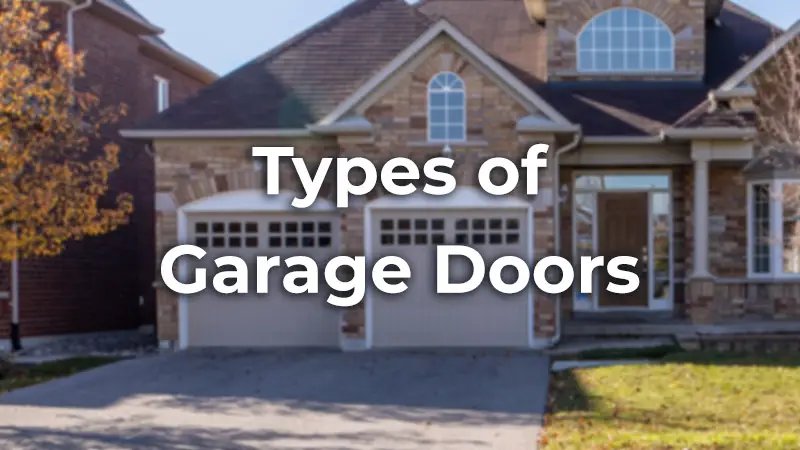There are many types of garage doors available on the market and often it’s not easy to find the one that meets all your needs.
Most homeowners end up opting for an overhead garage door, however, there are other options as well.
In this illustrated guide, I’ll show you all relevant types of garage doors so that you can choose the best fit for your garage.
Moreover, I’ll highlight the pros and cons of all options that will help you make an informed decision.
Now, without further ado, let’s dive in!
1. Sectional Garage Doors

These are one of the most common types of garage doors in the US. The vast majority of sectional garage doors have a linear design and are completely automatic (can easily be opened and closed using a garage door opener).
These overhead doors are usually made up of two sheets of steel with insulation foam between them. The thickness of an insulated sectional garage door is usually about 1.6 inches. Therefore they significantly reduce heat loss in winter and also provide a pretty good level of security.
When opening and closing, a sectional door goes straight up and down, so it never encroaches on the space outside the building. This feature is especially useful if only a small drive-through space is available in front of your garage.
When open, the door is completely parallel to the roof line (one part of the track is parallel to the wall, and the other is parallel to the garage ceiling).

Most sectional garage doors are fitted on the inside of the garage so they won’t restrict the width of the opening.
These types of garage doors usually come with a built-in safety sensor, so if anyone is underneath the door while it’s going down, they won’t get hurt because the door detects it and immediately starts going up.
Models with and without insulation are available, so you can choose the one that best suits your needs.
Pros:
- it does not extend beyond the piers on the outside (so it doesn’t encroach on the drive-through space)
- it does not narrow the opening
- you can choose from insulated and non-insulated models
- as it goes behind the piers, it’s suitable to cover arched (or any other shaped) openings without the need for any special door
- easy to operate
Cons:
- usually more expensive than most other types of garage doors (especially the insulated models)
- because of the more complex operation and structure, chances are greater that a component fails (although it’s not typical)
- regular maintenance is recommended (it’s more important than in the case of other types of doors)
2. Swing-Out Garage Doors (aka Side-Hinged Garage Doors)
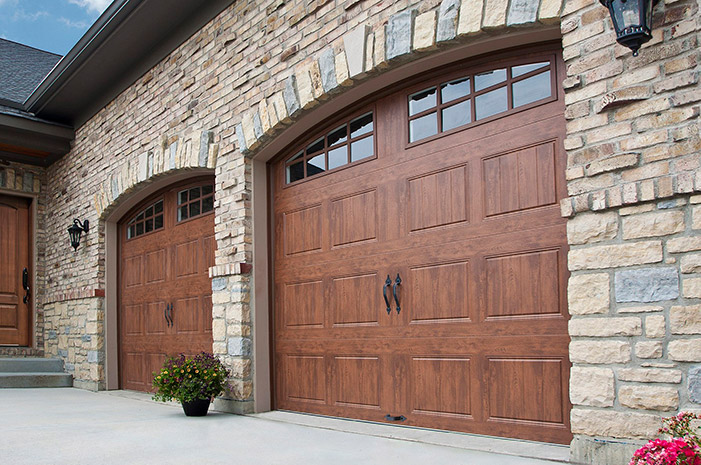
These garage doors are sometimes called carriage house style doors because they come from an era when carriage houses were widespread.
Regarding operation, a swing-out carriage door is pretty similar to most standard doors in a house (except that they open outward): hinges hold the door in place, and the door can be locked or unlocked using a key. However, automatic models are not uncommon either (if you’re willing to pay the extra cost).
Carriage style garage doors are usually made of wood and many of the higher-end models come with polystyrene or polyurethane insulation. This feature is highly important if you want to improve energy efficiency and avoid heat loss during the colder months.
Pro Tip: When it comes to insulation, always check the R-value of the garage door. The higher the R-value, the slower the transmission of heat, so less cold air is coming into the garage. Higher R-values mean the door is more energy efficient.
Carriage doors are getting popular and several manufacturers offer them, so you can choose from many designs or opt for a custom-built one.
Advantages:
- classic, old-fashioned style
- it’s a perfect choice if you need a visually appealing garage door that stands out
- custom design is available (with decorative hardware, premium materials, etc.)
- easy to operate (especially the automatic models)
Disadvantages:
- higher-end models are costly
- it opens outward, so it takes up space in front of the garage on the driveway
- wood is more sensitive to humidity, snow, and salt than steel, and not properly maintained or manufactured doors might warp or even rot over time
3. Roll-Up Garage Doors
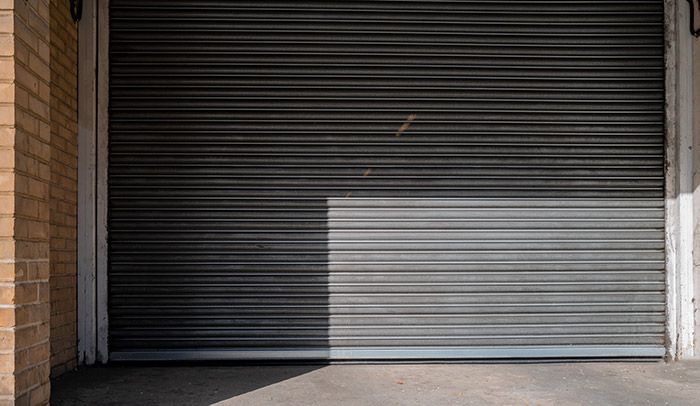
If you need a really compact solution, your best bet is probably a rolling garage door. It consists of several slats of steel or aluminum that roll up on an overhead barrel.
The main advantage of a roller garage door is that there’s no need for horizontal tracks, thus it’s an ideal choice for low indoor heights or when saving space is required.
The space between the two metal layers is usually filled with insulating foam (double skinned), therefore the door itself has a pretty secure and durable structure. This is why it’s frequently used as a commercial garage door. If you need a less expensive solution, you can choose the single skin version without insulation.
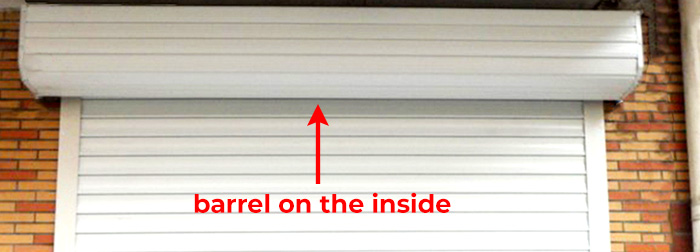
The obvious disadvantage of this type of overhead door is that its appearance is limited, so custom build doors are not a real option. As for the design, the main things you can customize are color and finish.
The typical installation of a roll-up door is behind the opening of the garage (so there’s no loss of width), however, fitting in between, and outside the opening is also possible.
A roller door operates pretty smoothly and most of them work flawlessly with a garage door opener.
If you need a steel or aluminum garage door and have limited space, a roll-up door can be an ideal choice.
Benefits:
- compact solution
- does not narrow the drive-through width
- requires little maintenance
- can be automatic
- durable structure
- most models are insulated
Drawbacks:
- limited design and appearance
- not budget-friendly
FYI: If you want to know some tried and tested ways to secure garage windows, don’t miss my article here.
4. Canopy Tilt-Up Garage Doors (aka Up & Over Garage Doors)

Unlike sectional garage doors, tilt-up doors consist of one single piece that tilts up and down as a whole. They are usually made of steel, wood, PVC, or GRP (fiberglass).
These types of garage doors were more popular 50-60 years ago, nowadays it’s not so common for such doors to be newly installed. However, they can be an optimal choice when quick installation and affordability matter.
A canopy garage door runs vertically on the tracks (there are no horizontal tracks), and in an open position (when it’s parallel to the ceiling) part of it, about a third of the door, to be more precise, protrudes from the plane of the front of the building. So when it’s open, it forms a small canopy (hence the name).
These doors usually use torsion springs and steel cables, and many of them come with a built-in anti-drop safety device to prevent accidents in case a spring or cable breaks (properly maintained doors rarely fail).
Pros:
- quick to install and it does not restrict the drive-through width
- old but proven technology
- easy to maintain
- few parts mean fewer potential failures
Cons:
- no real insulation
- it’s not sealed
- requires manual operation (converting to automatic is possible but pretty expensive)
- models without an anti-drop device can be dangerous in case of a failure
FYI: If you need to lock your garage door from the outside, make sure you check out the best methods here.
5. Retractable Tilt-Up Garage Doors
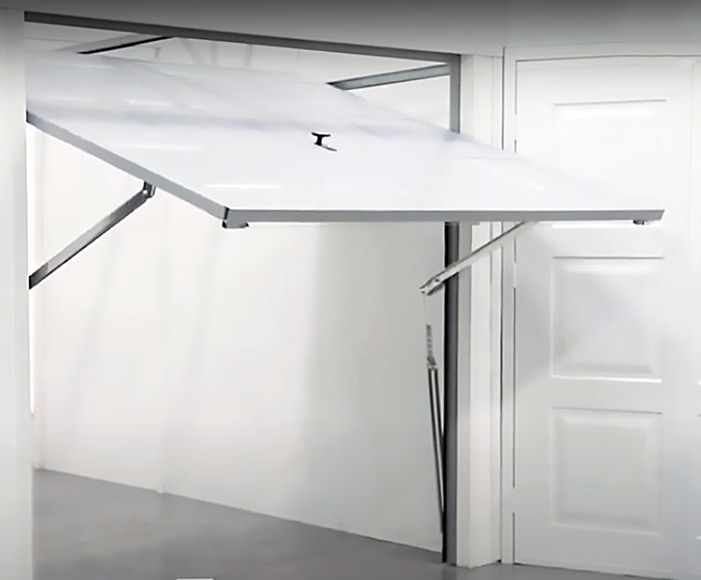
A retractable garage door is also a single-panel door. It runs on horizontal tracks and, unlike a canopy garage door, it does not extend beyond the piers in a horizontal position.
Also, it usually works with an electric operator, so you can use a door opener remote to conveniently open and close it without having to get out of your car. Another benefit of a retractable door is that even if you own a manual one, it’s much easier to automate than a canopy door.
These garage doors typically require more space in the garage, as they need horizontal tracks and usually an electric operator that will reduce the height of the garage. Also, most models reduce the drive-through width to some extent.
Pros:
- designed to be automatic
- more comfortable to use
- reduced noise compared to canopy doors
Cons:
- no insulation and no seal
- the more complex construction increases the chance of a failure
- require more space in the garage
6. Side Sliding Garage Doors (aka Round the Corner Doors)
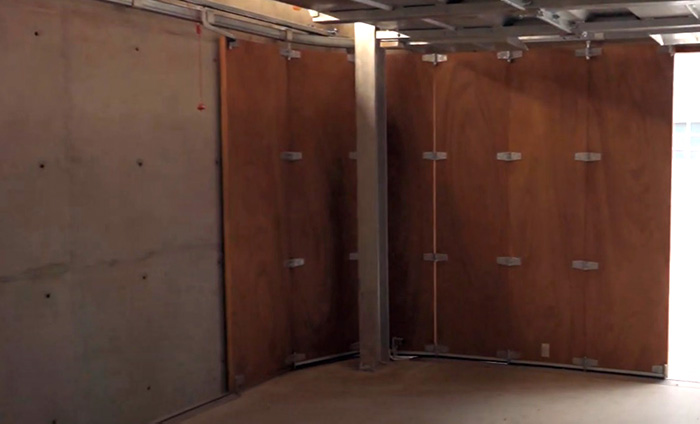
Slide-to-the-side garage doors are not so common, probably because their operation wasn’t completely flawless in the past. However, today’s modern models are much more reliable.
A side sliding door consists of multiple sections (similar to a sectional door) and opens to the side (instead of upwards) on a rail.
Both automatic and manual models exist, and if the opening is wider than usual, you can also opt for a bi-parting model.
The main advantage of side sliding doors is that they leave the ceiling untouched. Therefore they’re usually a good choice if the indoor height of the garage is small or if you don’t want the door to cover the ceiling for any reason.
Obviously, it takes up space on the side so this is something you need to take into consideration. If you have a narrow garage, you might be better off choosing another type of door.
Benefits:
- easy operation
- allows you to have access to the entire garage ceiling
- requires little maintenance
- no overhead operator
Disadvantages:
- narrows the interior width of the garage
- in the case of models with a floor rail, debris, such as stones or leaves, or frozen water or snow can cause a failure
- it’s on the higher end of the price spectrum
7. Bifold Garage Doors

Bifold doors are not widespread, and not many manufacturers offer them. The reason I included them on this list is that if someone doesn’t like overhead doors or needs something different that really stands out, a bifold garage door can be a reasonable choice.
Most bifold doors fold to the side and are operated manually, but for an extra cost, you can get an automatic one too. They’re usually made of wood, therefore they look natural and can come in many different designs.
The doors run on a rail that’s attached to the upper part of the opening. When opening, some models protrude inward and some outward depending on the implementation.
Bifold doors won’t work well on an obstructed or uneven floor space. That’s something you need to keep in mind if you want a hassle-free installation.
Pros:
- uncommon structure that stands out
- visually appealing design
- customization is available
- allows you to control the extent of opening
Cons:
- can be expensive, especially the automatic models
- requires even surface for operation
- takes up space either inside or outside the garage depending on the configuration
- usually heavier than other doors
Different Types of Garage Doors: Putting It All Together
As you can see, there are many kinds of garage doors to choose from, and by now you’re aware of the pros and cons of each type.
Garage doors come in many styles and designs and can be made of many different materials, such as steel, wood, aluminum, vinyl-clad, or fiberglass-clad.
If you have a standard garage and simply need a reliable, convenient, and safe door, in most cases you can’t really go wrong with a sectional door.
If you need something special, that’s both impressive and unique, opt for either a bifold or a wooden carriage door. These are not so common (especially the first option), therefore they are usually a more expensive option than most other types of doors. However, you can be sure they’ll stand out.
In case there’s not much space in your garage and need a compact solution, a roll-up door could be the ideal choice. Automatic and insulated models are both convenient to use and energy-efficient.
If you don’t want to cover the ceiling but your garage has enough room on the sides, you may want to consider installing a side sliding door. This will leave the ceiling intact, so it’s also perfect for buildings with low indoor height.
Photos: Wikimedia (Doordoctor), Flickr (Miss Shari)


